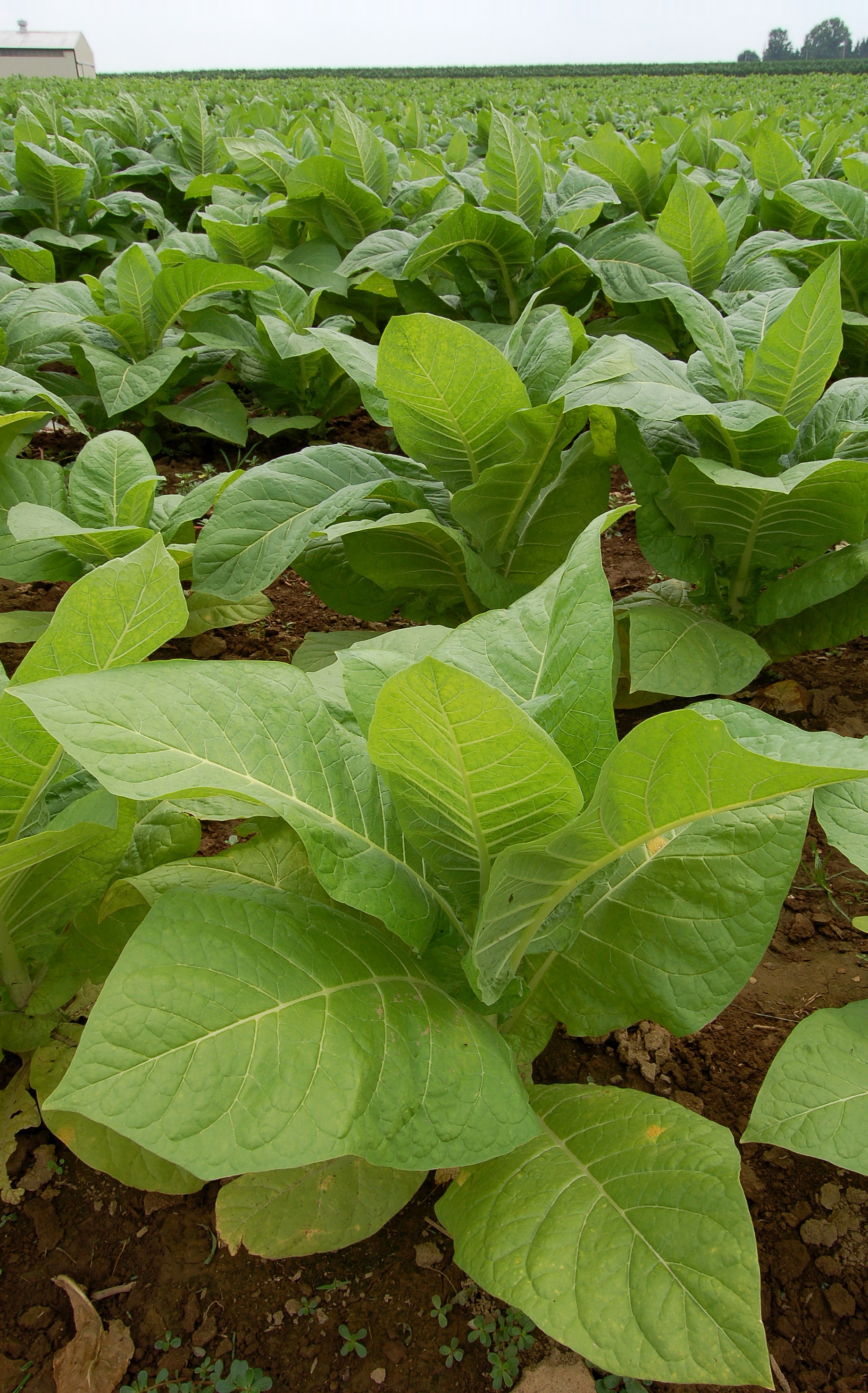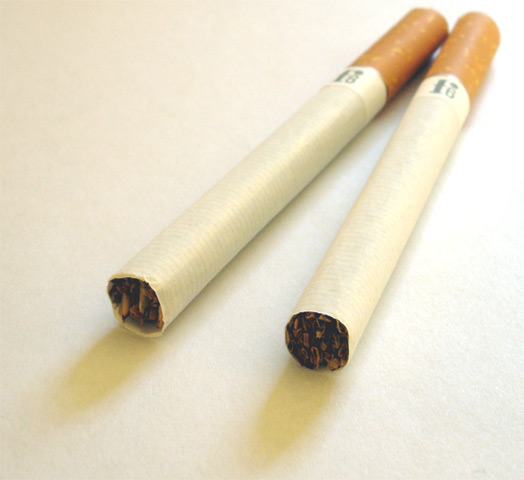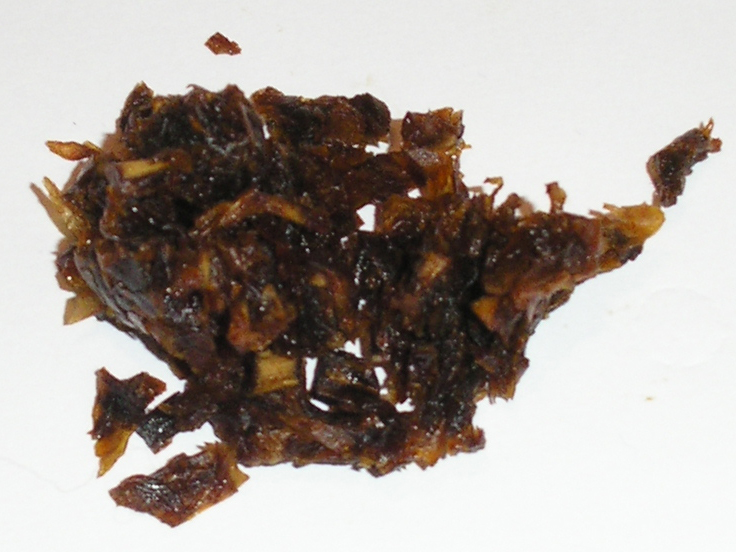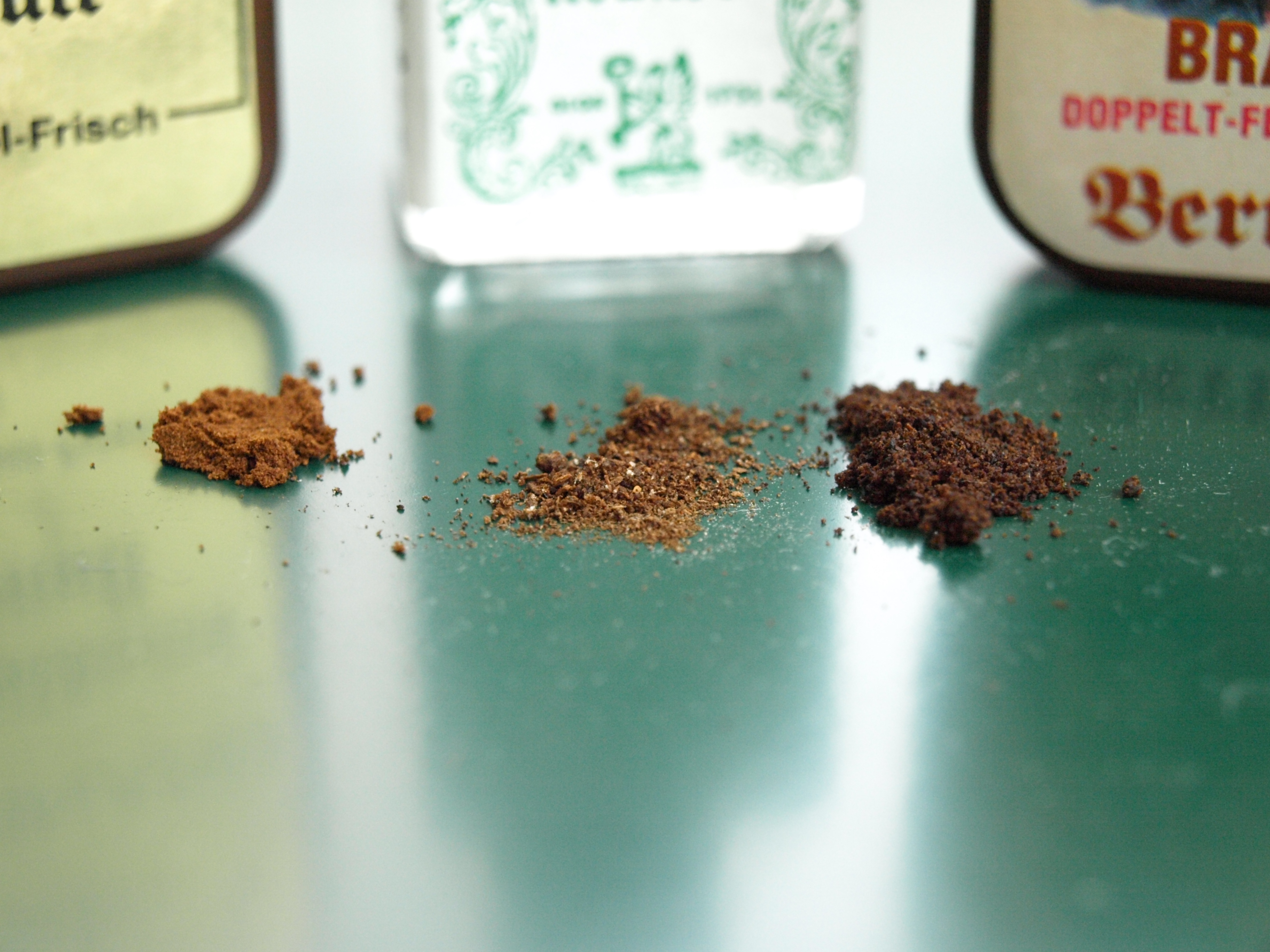List of tobacco products
This article needs additional citations for verification. (December 2014) |
| Part of a series on |
| Tobacco |
|---|
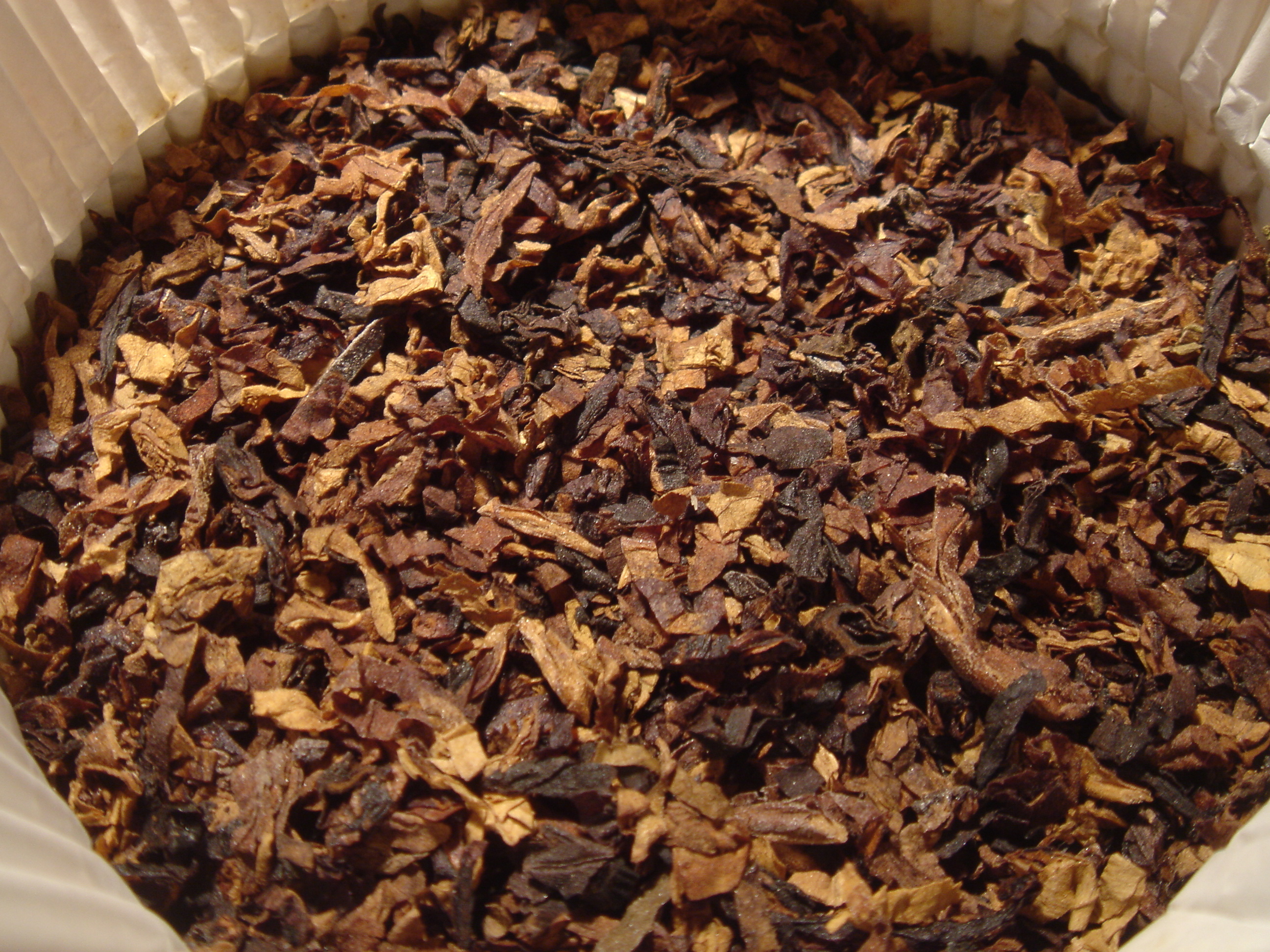 |
| History |
| Chemistry |
| Biology |
| Personal and social impact |
| Production |
Tobacco is the agricultural product of the leaves of plants in the genus Nicotiana, commonly termed tobacco plants. All species of Nicotiana contain the addictive drug nicotine—a psychostimulant alkaloid found in all parts of the plants except the seeds, and most heavily-concentrated in the leaves—which occurs in varying amounts depending on the species of Nicotiana grown; the breed, type, or variety of tobacco cultivated and produced; and the method used to cure and process tobacco leaves once they have been harvested.
This article provides a list of tobacco preparations and products. This list includes both tobacco products meant for consumption and those intended for other uses. Under the heading of consumable tobacco products, several categories of tobacco product are described in this list. Of these four basic categories, the first two include what are most often traditional types of tobacco products and preparations, relegated to the broad sub-categories of smoked tobacco and smokeless tobacco; the latter two categories include those types of tobacco products which have only recently been developed or widely adopted: heated tobacco products and nicotine-only products. Following is a brief description of each of these categories:
- Smoked tobacco products – Tobacco-containing products which consist of tobacco meant for smoking. Common smoked tobacco products include cigarettes, cigars, and hookah tobacco (usually mu'assel).
- Smokeless tobacco products – Tobacco-containing products used in a manner which does not produce smoke, while still being distinct from heated tobacco products. Common smokeless tobacco products include dipping tobacco (also called moist snuff or dip), snus, and the various forms of chewing tobacco.
- Heated tobacco products – Tobacco-containing products used by heating tobacco in order to produce an aerosol or particulate suspension that can be inhaled. Also known as heat-not-burn tobacco products or smokeless cigarettes, common lines of heated tobacco products include IQOS tobacco cylinders and the loose tobacco blends vaporized in Pax dry herb vaporizers.
- Nicotine-only products – Nicotine-containing products that do not contain tobacco, featuring nicotine either extracted from tobacco or non-tobacco nicotine, usually synthetic nicotine. Common nicotine-only products include e-liquid (aerosolized using an e-cigarette or vape), nicotine pouches, and various types of nicotine replacement therapy products.

Overview
Cultivation and types of tobacco
The vast majority of commercially-available tobacco is derived from the species Nicotiana tabacum (cultivated tobacco or common tobacco), although to a lesser extent it is also produced from Nicotiana alata, Nicotiana clevelandii, Nicotiana longiflora, and Nicotiana rustica, among others.Template:Fix/category[citation needed] (This is especially the case in certain areas, among particular cultures, or by certain industries or businesses; for example, the use of N. alata to produce particular kinds of hookah tobacco by various tobacco companies or retailers in Iran.) N. rustica (called Aztec tobacco, strong tobacco, thuốc lào in Vietnam, mapacho in South America, and makhorka (Russian: маxорка) in Russia) in particular contains much more nicotine than N. tabacum and other species of Nicotiana, and forms the basis of a number of unique tobacco products, as well as typically noncommercial preparations traditionally used in a shamanic, spiritual, or entheogenic context by various Indigenous peoples of the Americas. (For example, the use of rapéh mapacho snuff by Indigenous Brazilians.)
Once tobacco has been grown, harvested, cured, and processed, it is used to produce a number of different products, both commercial and noncommercial. These are most often consumable; however, tobacco and the nicotine derived from it are also used to create pesticides.
Terminology
Tobacco products, when the term is used to refer specifically to those products which contain material from the tobacco plant and are intended for consumption, often implies two general categories of product: smoked tobacco and smokeless tobacco.
When the term tobacco product is used to refer to any product containing tobacco or nicotine and intended for consumption, a third and fourth category of such products may become relevant, and especially with regard to recent developments in methods of nicotine consumption: heated tobacco products (HTPs) and nicotine-only products (also called alternative nicotine products or simply nicotine products)—the term itself essentially a misnomer because, while nicotine-only products do not contain tobacco, but rather nicotine in the absence of tobacco, they typically also contain other ingredients besides nicotine—both of which function to deliver nicotine to a user while potentially providing harm reduction from the negative effects of ingesting tobacco smoke (which contains tar, carbon monoxide, and other dangerous constituents) or the high level of carcinogenic nitrosamines normally found in tobacco.
An expert in tobacco, tobacco products, and tobacciana (objects, accoutrements, and paraphernalia associated with tobacco consumption, and especially items of historical or collectible value)—namely pipes, pipe tobacco, and cigars—including their procurement and sale, is called a tobacconist. (The term tobacconist may also refer to the type of business run by tobacconists; to a lesser extent the word refers to retail outlets, often called smoke shops or head shops, that typically sell tobacco products alongside other smoking products, legal psychotropics, cannabis culture-associated products and paraphernalia, and related consumables and accoutrements.)
Health impacts
Tobacco products

The health effects of tobacco consumption are significantly deleterious: tobacco use, and especially smoked and smokeless tobacco use, is associated with the development and aggravation of numerous diseases, many of which may lead to mortality or a lessening of lifespan and quality of life. Nicotine is an exceptionally addictive chemical, its repeated consumption associated with a high likelihood of developing a physical and psychological dependence upon the substance. (Additionally, nicotine withdrawal is associated with nicotine cessation following addiction or habituation to nicotine—this includes the discontinuation of tobacco smoking.)
While nicotine is one of the most widely-used recreational drugs, the consequences of its popularity and addictiveness are considerably negative. The effects of the prevalence of tobacco consumption upon society include what has long been the leading preventable cause of death worldwide, economic losses, and serious strains upon the healthcare systems of various countries.
There is some evidence to suggest that when nicotine is consumed in the form of tobacco, MAOIs called harmala alkaloids present in the tobacco leaf may interact with nicotine in the body to increase its effects, and therefore addictiveness.
Nicotine-only products

Less clear than the health impacts of tobacco use—though still concerning to many medical professionals—is the impact upon health and society at large of nicotine-only products, and the sheer preponderance and rapid growth of what is their relatively recent adoption for use: that is, nicotine-containing products which do not contain tobacco, i.e. non-tobacco products which contain either nicotine isolated from tobacco or non-tobacco nicotine. (NTN (as abbreviated by the U.S. Food and Drug Administration), mainly consisting of products containing synthetic nicotine.)
This type of product mainly includes nicotine products consisting of nicotine—typically free nicotine, nicotine salts, or nicotine polacrilex—combined with other ingredients, which themselves may or may not be harmful to health depending on the particular ingredients in question and the route of administration involved.
E-cigarette liquid (otherwise known as vape juice, e-liquid, vape oil, or simply juice), for instance, may contain ingredients that when vaped (aerosolized and inhaled) alongside nicotine, such as formaldehyde, are harmful to health and well-being. However, scientific evidence currently points to the possibility that e-cigarettes are at least somewhat safer than conventional (combustible) cigarettes.
The use of nicotine, either in the absence of tobacco or via tobacco consumption, produces a number of physiological effects. These include, but are not limited to: a form of euphoric intoxication typically known among recreational users as a buzz, nicotine buzz, or nic buzz; changes in blood pressure and circulation; and acute—or, with frequent or repeated use, chronic—alterations of the hormonal, cardiac, gastrointestinal, and central nervous systems; with acute adverse effects including nausea, lightheadedness, sleep disturbances, rapid heart rate, and headaches.
The only medicinal nicotine agents currently approved as safe for medical intervention—namely nicotine cessation—are nicotine replacement therapy products.
Consumable
Smoked tobacco
Cigars
A cigar is a tightly rolled bundle of dried and fermented tobacco which is ignited so that its smoke may be drawn into the smoker's mouth and expelled; thus the cigar is generally "puffed on" (like a tobacco pipe) as opposed to being inhaled from (as is the case with cigarettes). The cigar is one of the oldest methods of preparing tobacco for consumption, some of the first cigars being introduced to Europeans as rolls of tobacco smoked by the Taíno people of 15th century Cuba.
There are numerous varieties of cigar, differentiated by their size, shape, color, and composition. Some products developed from the cigar are, however, markedly different from the traditional product. (Cigarillos, blunts, and little cigars, for instance.) Cigarettes may be the most notable example of this deviation, although they do, in a sense, represent a category of their own.
Tobacciana associated with cigars include cigar ashtrays, cigar tubes, cigar boxes, cigar holders (also known as cigar mouthpieces, which are similar to cigarette holders), cigar cutters (including cigar scissors or shears), cigar cases, and humidors.
Blunts
This section needs expansion with: information from the main article. You can help by adding to it. (January 2009) |
Blunts are wide, somewhat stubby versions of cigars. Most, if not all, are machine-made "domestic cigars" created from homogenized or reconstituted tobacco. They are usually inexpensive, and only lightly fermented.
Cigarillos
This section needs expansion with: information from the main article. You can help by adding to it. (January 2009) |
Cigarillos are long, thin cigars, somewhat larger than cigarettes but smaller than regular cigars. They may be fitted into a cigarillo holder in order to be smoked, though they are most often smoked without such a device. Using a cutting tool in order to prepare a cigarillo is less common than with larger cigars, as they are often open on both ends. Cigarillos may be machine-made, although many hand-made versions do exist; the latter are often produced by premium cigar manufacturers. In modern-day America, machine-made cigarillos can be used as marijuana cigars in a manner similar to machine made-large cigars.
Little cigars
This section needs expansion with: information from the main article. You can help by adding to it. (January 2009) |
A little cigar is a cigar that is the same size as a cigarette—often featuring a filter—however, it still retains its identity as a cigar because it is wrapped in a tobacco leaf, or more often a paper wrapper made of tobacco pulp, reconstituted tobacco or homogenized tobacco. Flavored little cigars are available on the market as well. Flavored little cigars have been steadily increasing in popularity among cigar smokers. Manufacturers like Prime Time have been offering flavored little cigars since 1993.
Roll-your-own cigars
Several manufacturers have begun producing cigar wraps. Cigar wraps consist of tobacco leaf which can then be used with a tobacco blend to produce a hand-rolled cigar.
Cigarettes
This section needs expansion with: information from the main article. You can help by adding to it. (January 2009) |
Cigarettes are a product consumed through smoking and manufactured out of cured and finely cut tobacco leaves and reconstituted tobacco, often combined with other additives,[1] then rolled or stuffed into a paper-wrapped cylinder (generally less than 120 mm in length and 10 mm in diameter).
Bidis
This section needs expansion with: information from the main article. You can help by adding to it. (March 2013) |
Kreteks
This section needs expansion with: information from the main article. You can help by adding to it. (January 2009) |
Kreteks are cigarettes made with a complex blend of tobacco, cloves and a flavoring 'sauce'.
Roll-Your-Own
Roll-Your-Own (RYO) or hand-rolled cigarettes, are very popular particularly in European countries. These are prepared from loose tobacco, cigarette papers and filters all bought separately. They are usually much cheaper to make.
Creamy snuff
Creamy snuff is a tobacco paste, consisting of tobacco, clove oil, glycerin, spearmint, menthol, and camphor, and sold in a toothpaste tube. It is marketed mainly to women in India, and is known by the brand names Dentobac, Tona, Ganesh. It is locally known as "mishri" in some parts of Maharashtra. According to the U.S. NIH-sponsored 2002 Smokeless Tobacco Fact Sheet. The same factsheet also mentions that it is "often used to clean teeth". The manufacturer recommends letting the paste linger in the mouth before rinsing.
Dissolvable tobacco
Dissolvable tobacco is a recent introduction, entering mainstream use in the later half of the 2000s (decade). The product consists of finely-processed tobacco which is developed in such a way as to allow the substance to dissolve on the tongue or in the mouth. Camel tobacco is the major purveyor of dissolvable tobacco products, with three varieties, including strips, sticks and orbs, however companies such as Ariva and Stonewall have also been successful with such manufacturing, marketing compressed tobacco lozenges.
Dokha
Dokha is a tobacco of Iranian origin mixed with leaves, bark, and herbs. It is traditionally smoked in a midwakh.
Gutka
Gutka (also spelled gutkha, guttkha, guthka) is a preparation of crushed betel nut, tobacco, and sweet or savory flavorings. It is manufactured in India and exported to a few other countries. A mild stimulant, it is sold across India in small, individual-size packets. It is consumed much like chewing tobacco, and like chewing tobacco it is considered responsible for oral cancer and other severe negative health effects.Template:Fix/category[citation needed]
Used by millions of adults, it is also marketed to children. Some packaging does not mention tobacco as an ingredient, and some brands are pitched as candies - featuring packaging with children's faces and are brightly colored. Some are chocolate-flavored, and some are marketed as breath fresheners.Template:Fix/category[citation needed]
Kizami
This section needs expansion with: information from the main article. You can help by adding to it. (January 2009) |
Kizami is a tobacco product produced in Japan and intended for smoking in Japanese kiseru pipes.
Iqmik
Iqmik is an Alaskan smokeless tobacco product used with punk ash. It is most common among natives. Nicotine is freebased with caustic ash and thus iqmik is more addicting and potent than regular chewing tobacco.
Mu'assel
This section needs expansion with: information from the main article. You can help by adding to it. (March 2013) |
Mu'assel, shisha tobacco, hookah tobacco, or simply shisha is a somewhat moist form of tobacco that is mixed with glycerin and coagulated with molasses or other sticky sweeteners and has been popular in the Middle-East for centuries. It is often smoked with a hookah. Its names include ma'sal (also romanized as the aforementioned mu'assel), tumbâk, and jurâk.
Naswar
Naswar is a type of smokeless tobacco popular in Afghanistan and surrounding countries. It is moist and powdered, and lime or juniper is added for flavor.
Pipe tobacco
This section needs expansion with: information from the main article. You can help by adding to it. (March 2013) |
Snuff
Snuff is a generic term for finely-ground smokeless tobacco products. Originally the term referred specifically to dry snuff, otherwise known as nasal snuff, a fine tan tobacco dust, powder, or flour meant for light insufflation, or "snuffing", popular mainly in the 18th century. (Dry snuff is still used today, albeit much less often than other, more popular smoked and smokeless tobacco products.)
Several broad categories of dry snuff exist:
- American-style (dry) snuff — A form of nasal snuff originating from the United States, although based upon the earlier development of European-style nasal snuff, and intended for either snuffing into the nostrils or placing between the lip and gum, the latter method allowing for the product to be used like dipping tobacco. (Also known as (American) moist snuff.)
- European-style (dry) snuff – A style of dry snuff intended, almost exclusively, to be shallowly "sniffed" or "snuffed" into the nose, where nicotine is absorbed through the mucous membranes in the nostrils. (Snuff is not deeply "snorted" (such as in the way cocaine powder is) because snuff isn't intended to move beyond the nose, i.e. into the sinuses, throat or lungs.) European-style nasal snuff comes in several varieties:
- Plain (otherwise known as natural snuff) – A type of European tobacco snuff without the addition of flavorants.
- Rappee – The term rappee coming from the French râpé ("grated"), rappee is a type of coarse, pungent snuff made from dark tobacco
- Schmalzler – A type of snuff originating in Germanophone countries, schmalzler is schmalzed ("oiled").
- Toast – A very dry and finely-ground type of snuff.
European-style nasal snuff also comes in numerous different flavors or aromas, including the so-called medicated variety (nasal snuff made with a scent basis of menthol, camphor, or eucalyptus).
- Rapé (pronounced "hah-peh"; also transliterated rapéh, hapé, and hapéh) – A traditional preparation of tobacco, namely mapacho (N. rustica) leaves: the prototypical form of dry or nasal snuff typically used in a shamanic, entheogenic, or ethnomedicinal context by certain Indigenous peoples of the Amazon Basin. The term rapé is the etymological origin of the word rappee, a particular style or form of European dry snuff.
In the U.S., dry snuff is often called "Scotch Snuff", a folk-etymology derivation of the scorching process used to dry the cured tobacco by the factory. European snuff powder originated in the UK town of Great Harwood and was famously ground in the town's monument prior to local distribution and transport further up north to Scotland.
European (dry) snuff is The major brand names of European snuffs are: Toque Tobacco (UK), Bernards (Germany), Fribourg & Treyer (UK), Gawith (UK), Gawith Hoggarth (UK), Hedges (UK), Lotzbeck (Germany), McChrystal's (UK), Pöschl (Germany), Toque (UK), and Wilsons of Sharrow (UK).Template:Fix/category[clarification needed]
Although less common, American (dry) snuff also exists, and is typically used orally in a similar manner to moist snuff. It is placed in the lower lip, and is most popular in the South. Brands include: Carhart's CC, Peach Sweet, and Tube Rose, among others.
Generally, a small portion of dry snuff is either pinched in the fingers or laid out on the wrist of the user, from where it is sniffed.
Moist snuff, a product of American origin, is synonymous with dipping tobacco or dip.
Snus
Snus is a type of smokeless tobacco originating from and popular in Sweden and other Scandinavian countries. It differs from moist snuff or chewing tobacco in that it is made from steam-cured tobacco leaves, rather than fire-cured ones, and its health effects are markedly different, with epidemiological studies showing lower rates of cancer and other tobacco-related health problems than cigarettes, American "chewing tobacco", Indian gutka or African-type tobacco products. Prominent Swedish brands are Swedish Match, General, Ettan, and Tre Ankare. In many Scandinavian countries, snus comes either in loose powder form, to be pressed into a small ball (called "baking" the snus) by hand or with the use of a special tool, or in small bags (called "portioned snus" form). Both are suitable for placing under one of the lips, most often the upper. Portioned snus is in particular a popular type because it keeps loose tobacco from becoming stuck between the user's teeth; they also produce less spittle when in contact with mucous membranes inside the mouth which extends the usage time of the tobacco product. However, loose form snus tends to deliver more nicotine than portioned form.
Tobacco edibles
Tobacco gum, like dissolvable tobacco, is a recent introduction - a type of chewing gum which, like nicotine gum provides nicotine through oral absorption. However, the difference between nicotine gum and tobacco gum is that tobacco gum is made from finely powdered tobacco mixed with a gum base, rather than freebase nicotine.
Smokeless tobacco
Smokeless tobacco products are those tobacco products which do not require smoking to consume. More specifically, the term smokeless tobacco refers to such products without reference to HTPs and nicotine-only products.
Chewing tobacco
Chewing is one of the oldest methods of consuming tobacco leaves. Native Americans in both North and South America chewed the fresh leaves of the tobacco plant, frequently mixed with lime.
Kinds of chewing tobacco can broadly be divided into types from the Western world and those of Eastern origin, namely from the Indian subcontinent.
- Western chewing tobacco
Modern American-style chewing tobacco (colloquially known as chew or chaw, especially in the American South and Midwest) is produced from cured and often fermented tobacco, usually dampened and mixed with some type of sweetener. (Often molasses.) Twist tobacco may be an exception in this case, as many brands of twist are not sweetened.
In using chewing tobacco—at least types other than tobacco pellets—the consumer usually deposits the tobacco between the cheek and teeth and lightly macerates and sucks the tobacco to allow its juices to flow. Thus when chewing, it is common to spit and discard excess saliva caused by the release of juices from the tobacco, justifying the existence of the spittoon, or cuspidor.
The popularity of American-style chewing tobacco and the associated spittoon reached its height in the American Midwest during the late 19th century; however, as cigarettes became the predominant form of tobacco consumption the spittoon gradually fell into disuse across the United States. While spittoons are often a rarity in modern society, loose leaf chewing tobacco can still be purchased at many convenience stores or from tobacconists throughout the United States and Canada.
Chewing tobacco endemic to the Western world is manufactured in several forms:
- Loose leaf
Loose leaf chewing tobacco, also known as scrap, is perhaps the most common contemporary form of American-style chewing tobacco. It consists of cut or shredded strips of tobacco leaf, and is usually sold in sealed pouches or bags lined with foil. Often sweetened, loose leaf chew may have a tacky texture. (Though there are also unflavored or "natural" loose leaf chews. However, these are far less common.) Popular, modern brands of scrap sold in North America include Red Man, Levi Garrett, Jackson's Apple Jack (made by Swisher International), Beech-Nut (formerly made by Lorillard; now Reynolds American), and Stoker's.
- Pellets
Pellets or bits consist of tobacco rolled into small pellets. They are often packaged in portable tins. Tobacco pellets are used in the same manner as snus, in that they are placed between the lip and gum, and that spitting is typically unnecessary. It is suggested that the user may periodically chew the pellets lightly in order to release additional juice, flavor, and/or nicotine. Tobacco bits are almost exclusively produced under the Northern European Oliver Twist and Piccanell brands. They are thus—like snus—preponderant in the Scandinavian region.
- Plug
Plug tobacco is made up of tobacco leaves that have been pressed together and bound by some type of sweetener, resulting in a dense, square tobacco mass. (Some compare the look of plug tobacco to a brownie or similar pastry.) One can then bite directly from the mass or slice the tobacco into portions. Some types of plug may either be chewed or smoked in a tobacco pipe, and some are exclusive to one method of consumption or the other.
Plug tobacco was once a much more common product, available to many American consumers during the 19th century. Two tobacco companies that historically manufactured plug are Liggett and Lorillard. (The latter was known for its Climax brand of plug.)
Modern brands of chewing plug include "rustic" and simple packaging, as is the case with popular plugs like Apple Sun Cured, Brown's Mule, Cannon Ball, Cup, Days Work, and Days O Work. Some well-known loose leaf chewing tobacco brands, such as Red Man and Levi Garrett, have their own versions of plug tobacco, as well.
- Sticks
Chewing tobacco sticks are tightly bound rolls or "sticks" of chewable tobacco, usually sold in pouches.
Brands include the German Grimm und Triepel and the Brazilian La Corona.
- Twist
Twist or rope tobacco is made up of rope-like strands of tobacco that have been twisted together and cured in that position, afterwards being cut. Some types of twist may either be chewed or smoked in a tobacco pipe, and some are exclusive to one method or the other.
Unlike other types of chewing tobacco, twist tobacco isn't always a sweetened product, and may be devoid of molasses.
Different types of chewing tobacco are endemic to various parts of India and the surrounding regions:
- Indian chewing tobacco
- Gutkha
Gutkha (also transliterated gutka) is a chewing tobacco product popular in India and surrounding regions.
It is a mixture of betel nuts, tobacco, paraffin wax, catechu, and slaked lime.
It is similar to mava.
- Mava
Mava (also transliterated mawa) is a chewing tobacco product popular in Gujarat, India, made with a mixture of betel nut, calcium carbonate and flavoured tobacco. It is also known faki or masala.
It is similar to gutkha.
- Tambaku paan
Tambaku paan is a type of paan with tobacco. It contains many of the same ingredients as gutkha.
Dipping tobacco
This section needs expansion. You can help by adding to it. (August 2008) |
Dipping tobacco, also known as dip, moist snuff (or simply snuff), American moist snuff, or spit tobacco, is a form of smokeless tobacco. Dip is sometimes also called chew or chaw; because of this, it is commonly confused with chewing tobacco. Because it is sometimes called snuff or moist snuff, it can also be confused with nasal or dry snuff.
Instead of literally chewing on dipping tobacco, as is the case with chewing tobacco, a small clump of dip is "pinched" out of its container and placed between the lower or upper lip and gums. While it is most common to place the tobacco between the lower lip and gums, utilizing the upper lip for this purpose—in a manner more common to snus—is known as an "upper decker".
In modern times, dipping tobacco is usually packaged in metal or plastic tins, sometimes with the addition of fiberboard. Some brands are packaged into "tubs", or deeper hand-held containers.
Dipping tobacco comes in several varieties. Many dipping tobacco producers also manufacture pouches of dipping tobacco, making the habit cleaner and more convenient. The following are standard cut sizes, but some brands can still vary in size.
Cut sizes:
- Extra long cut
Extra long cuts are the longest cut size. Copenhagen and Grizzly both make an extra long cut natural variety.
- Wide cut
Wide cuts have thicker strands than all other cuts of dipping tobacco. Currently, wide cut is only manufactured by Grizzly.
- Long cut
Long cuts are easier to manage than fine cuts (a smaller granular sized dip - in regard to ease of grabbing the tobacco and keeping it comfortably in mouth). This is the most common cut of tobacco.
- Mid cut
Mid cut sized dipping tobacco is comparable to small granules at about 1 mm cubed. A couple of mid cuts were on the smokeless tobacco market but have since been discontinued.
- Fine cut
Fine cut comes in granules slightly larger than sand or coffee grounds.
- Snuff
Snuff or simply moist snuff looks similar to dirt or sand in terms of granular size. Extremely small cut.
- Pouches
Pouches hold fine cut tobacco in a small teabag-like pouch for convenience. Pouches are typically about the same size, but one brand, Skoal, also offers a smaller pouch called Bandits.
Non-consumable
Tobacco water
Tobacco water is a traditional organic insecticide used in domestic gardening. Tobacco dust can be used similarly. It is produced by boiling strong tobacco in water, or by steeping the tobacco in water for a longer period. When cooled the mixture can be applied as a spray, or 'painted' on to the leaves of garden plants, where it will prove deadly to insects.
Basque angulero fishermen kill immature eels (elvers) in an infusion of tobacco leaves before parboiling them in salty water for transportation to market as angulas, a seasonal delicacy.[1]
Topical tobacco paste
Topical tobacco paste is sometimes recommended as a treatment for wasp, hornet, fire ant, scorpion, and bee stings.[2] An amount equivalent to the contents of a cigarette is mashed in a cup with about a 0.5 to 1 teaspoon of water to make a paste that is then applied to the affected area. Paste has a diameter of 4 to 5 cm (1.5 to 2 in) and may need to be moistened in dry weather. If made and applied immediately, complete remission is common within 20–30 minutes, at which point the paste can be removed. The next day there may be a some residual itching, but virtually no swelling or redness. There seems to be no scientific evidence, as yet, that this common home remedy works to relieve pain.[3] For about 2 percent of people, allergic reactions can be life-threatening and require emergency treatment. For more on this, see bee stings.
See also
References
- ↑ Angulas
- ↑ Beverly Sparks, "Stinging and Biting Pests of People" Extension Entomologist of the University of Georgia College of Agricultural & Environmental Sciences Cooperative Extension Service.
- ↑ Glaser, David. "Are wasp and bee stings alkali or acid and does neutralising their ph them give sting relief?". www.insectstings.co.uk. Archived from the original on 2007-06-26. Retrieved 2007-05-03.
- Articles needing additional references from December 2014
- Articles with invalid date parameter in template
- All articles needing additional references
- Articles using small message boxes
- Articles to be expanded from January 2009
- All articles to be expanded
- Articles with hatnote templates targeting a nonexistent page
- Articles to be expanded from March 2013
- Pages with broken file links
- Articles to be expanded from August 2008
- Tobacco products
- IARC Group 1 carcinogens
